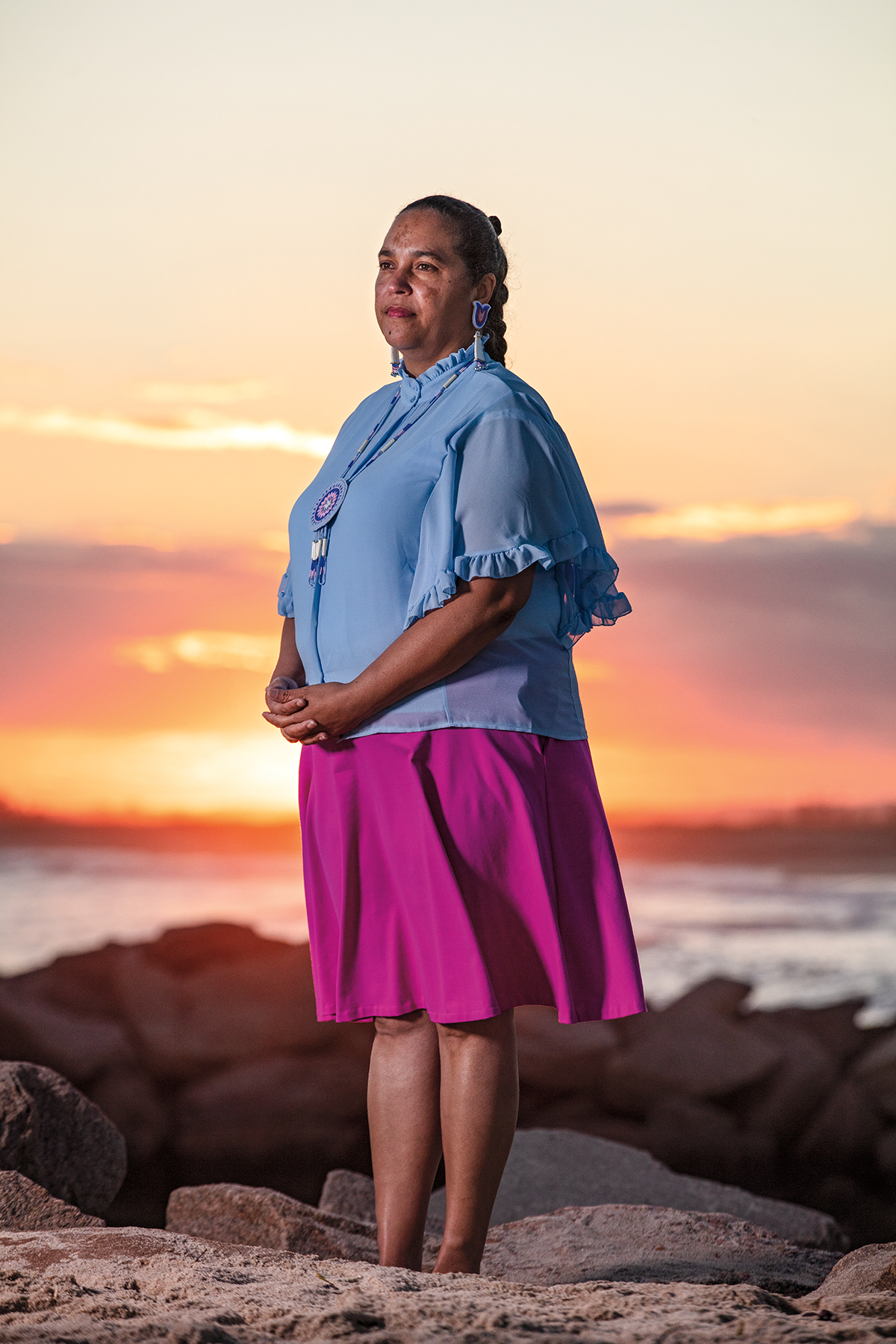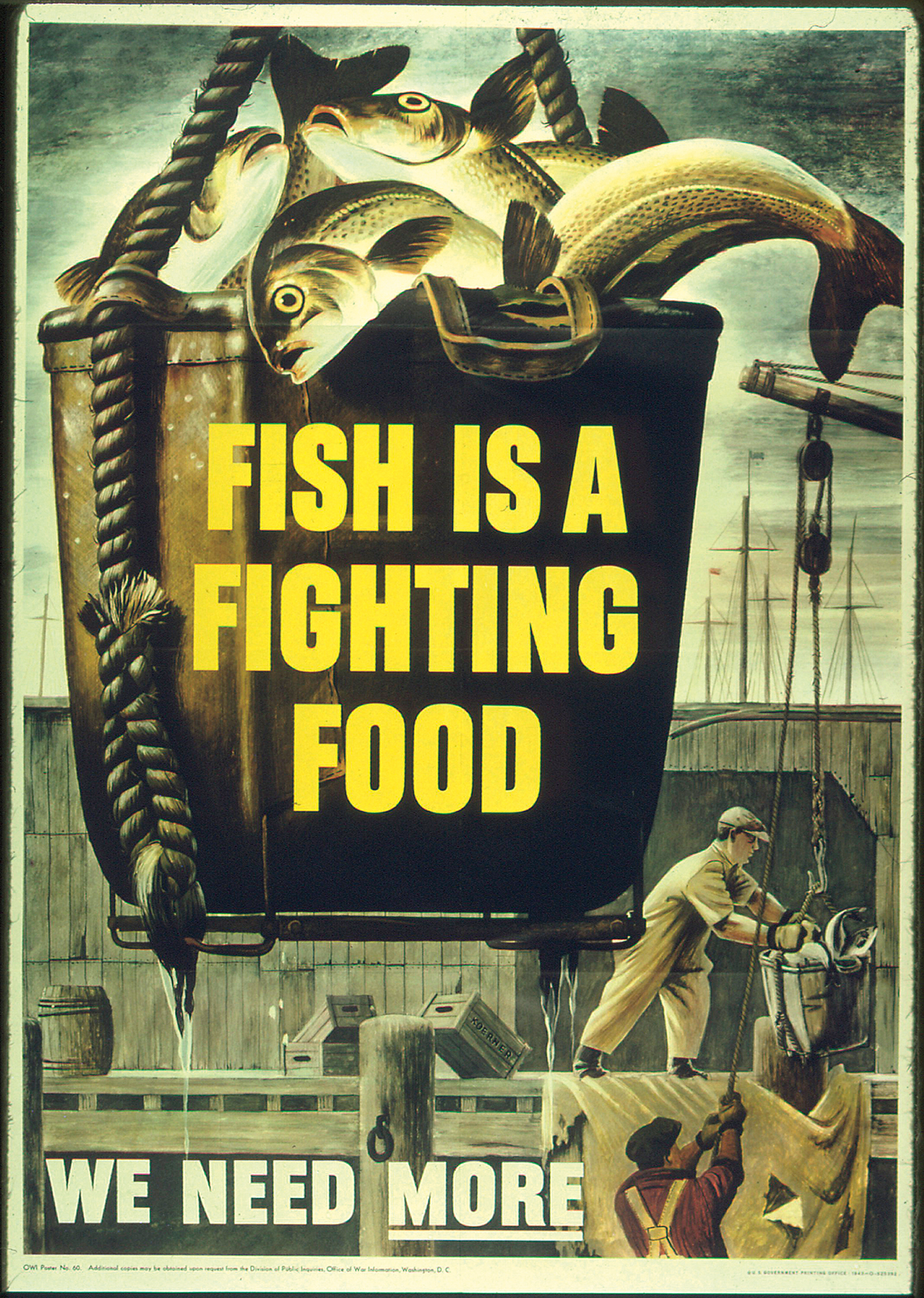In Times of Hardship, Saved by the Sea
SEVERAL YEARS AGO, A WOMAN APPROACHED MY TABLE as I offered seafood for sale at a Providence farmers market. Instead of gravitating towards the gleaming fillets of striped bass and the pearly white scallop meats at the front of the display, her gaze settled on a pair of whole scup lingering in obscurity at the back of the ice tray.
“Scup!” she exclaimed, as if seeing an old friend again after a long time. Then she explained: a few years earlier, she and her husband, both performing artists, were going through a gap between gigs. With their dollars running out, they turned to a place where they could fill their plates for free: Narragansett Bay.
“We caught and ate scup every night to get us through,” she said. “I still find scup scales under the fridge and in the cupboards. Those scales get everywhere, and they never go away!”
This couple’s story is not unique. Narragansett Bay, its tributaries, and Rhode Island’s ocean waters have unfurled their generous social safety net generation after generation for those in need. Their bright beaches and shimmery bayscapes—a space of carefree entertainment in boom times—double as something more essential in lean times: an aquatic food pantry, an underwater victory garden, a floating work relief program. In the midst of today’s global coronavirus pandemic, many Rhode Islanders are navigating the most economically uncertain time in living memory. It is a comfort to know that the sea has saved many before. Can it do so again?
GIFTS OF THE SEA AND THE LAND
For the original inhabitants of the land that is now Rhode Island, meals were not packaged or bought; they sprinted through the woods, swam through the creeks, and flew through the air.
“We always utilized the gifts of the sea and the land,” recounts Lorén Spears, who is the executive director of Tomaquag Museum, as well as an educator, activist, author, artist, and former councilwoman of the Narragansett Indian Tribe. “Prior to European arrival, we were thriving. Our ancestors were all using resources in their season. There wasn’t freezing, but we did preserve things through storing food in caches and drying and preserving: salmon, bluefish, a myriad of other saltwater fish, cod, sturgeon, whales, and things of that nature.”
After European conquest, Spears says, using the resources of the land and sea remained vital—not only for nutrition, but increasingly for cultural survival as well.
“As indigenous people, it’s important to be connected to the land and respect the gift of the land and waters, and make sure that the next generation knows how to hunt and fish and make things,” Spears explains. “Think of the Great Depression. Indigenous people weren’t necessarily affected by that the way that others were. We were used to living off the land. I remember hearing from my grandmother that people who were poor fared better than those who were wealthy, because they were used to living off the land and processing their harvest and their catch.” The need for these skills is becoming apparent again today, Spears adds. “Now we have food deserts and food insecurities that are creeping up into the middle class. People who have those skills are going to go out and harvest wild edibles and live from the land and hunt, fish, or gather their food.”

Lorén Spears, executive director of the Tomaquag Museum, says that the poor fared better than the wealthy during the Great Depression because they were used to harvesting their own food from the land and the water.
SALVATION, SWIMMING UPSTREAM
For farming families in the early republic, winter was a difficult time. Stored foods from the previous summer ran low, and cooks had to stretch their meager reserves. But each April brought sweet relief: a protein-packed replenishment coursing up the rivers in the form of salmon, alewives, shad, and blueback herring, all heeding a seasonal cue to sprint from the sea to their fresh-water spawning grounds.
Just as George Washington’s troops were purportedly saved by shad after months of starvation at Valley Forge, many early New Englanders survived thanks to the providential timing of the region’s anadromous fish cycles. Along the Blackstone, Pawtuxet, and Pawcatuck rivers, residents fished not only to feed themselves but also to feed their crops. Dense nutrients incorporated in these fishes’ bodies while feasting at sea gave a boost to the area’s sandy soils and helped ensure ample crop yields to feed the community.
Given their nutritional dependence on anadromous fish runs, it is no surprise that farming families faced off against pioneers of the Industrial Revolution over the construction of milldams to power factories. Unfortunately for these families, it was a losing battle.
Despite extolling the importance of anadromous fish runs in providing for “the poorer Sort of people,” state authorities allowed industrial progress to proceed of its own accord. By the early 19th century, Rhode Island’s once free-flowing rivers were splintered into fragments by milldams and waterwheels. Springtime salvation no longer came swimming upstream, and farming families lost a source of reliable protein.
THE MACKEREL YEAR
The summer of 1816 was like no other. Spring’s lengthening days went dark, as a dry fog settled in over the fields and towns, reddening the sky and making sunspots visible to the naked eye. Snow fell in June, ice formed on ponds, and frost gripped the young crops. New Englanders who had food hoarded it, and everyone else scrambled to survive.
The cause of this apocalyptic weather was a volcano on Mount Tambora, Indonesia. Its eruption, which today still ranks as the most powerful volcanic eruption in recorded history, filled the Earth’s atmosphere with ash and lowered temperatures across the globe.
New Englanders who lived through that nightmarish year called it the “Year without a Summer,” the “Poverty Year,” or “Eighteen Hundred and Froze to Death.” But they also gave it a more appreciative name—the “Mackerel Year”—in honor of the fish that saved them.
“As harvest failure and famine forced New Englanders to look to coastal seas for sustenance, the only fish available in large quantities near commercial distribution centers was mackerel,” a team of climate scientists at the University of Massachusetts at Amherst explained in a 2017 study.
Their research showed that alewives and shad—already diminished due to the damming of their spawning rivers—remained at sea in 1816 because freshwater temperatures were too frigid for them to migrate upriver. But marine-spawning fish like mackerel were more resilient.
“[H]istorical records suggest that desperate people turned to mackerel in extremis because mackerel were available early and in great numbers when other species were not,” the climate researchers concluded.
The effects of this switch were long-lasting. Fisheries infrastructure and markets were reconfigured for mackerel, and before long, this once overlooked fish had become an indispensable staple of the New England diet.
A BAY FOR ALL PEOPLE
On October 24, 1929, a cataclysmic stock market crash slammed the door on the Roaring Twenties and shook the country to its core. In the decade that followed, countless Americans lost their savings, their jobs, and their homes. At the peak of this Great Depression, parts of Rhode Island saw unemployment rates surpassing 30%.
IT WAS EVERY AMERICAN'S DUTY TO CHOOSE FISH
Luckily for some, Narragansett Bay was undergoing a transformation in benthic ecology that would tilt in favor of the struggling lower and middle classes.
Ever since the Gilded Age of the late 19th century, the bay had been dominated by a constellation of privately owned leases held by prosperous “oyster barons.” But by the 1920s, pollution, siltation, and starfish predation were making it harder for oyster companies to remain viable. Many chose to relinquish their leases. These areas, once off-limits for wild harvest fishing, reverted to the “free and common” fishery.
Without the restocking of “cultch,” or oyster shell substrate, the previously ubiquitous oyster began to disappear from Narragansett Bay. In its place, a previously inconsequential species ascended in importance: the quahog.
By 1931, more than a thousand Rhode Islanders were employed in the harvest and selling of quahogs. This species swap could not have come at a better time for Rhode Island’s struggling masses. “Owing to the business depression,” stated the Rhode Island Commissioners of Shell Fisheries in 1932, “the number of persons procuring shellfish from our shores have doubled in number, giving many employ-ment. The Commissioners have opened certain closed areas for the taking of seed oysters for the purpose of transplanting by licensed fishermen, assisting them in obtaining a livelihood.”
The Scalloptown community in East Greenwich made their living from the bay for generations.
September 14, 1930. Photo courtesy of The Providence Journal
A FIGHTING FOOD
During World War I, the U.S. Department of Commerce published a bulletin encouraging the public to eat oysters during wartime, calling it “a duty to utilize this vast food resource as far as possible and save other foods of which there is a dearth.”
Then in World War II, the Office of War Information produced a poster with the words “Fish is a fighting food.” The message of these publications was clear: during wartime, it was every American’s patriotic duty to choose fish for dinner. However, fish is a finite resource, and seafood promoters realized that if all Americans were to eat more fish, fish supplies would soon become scarce. Therefore, they began encouraging Americans not only to eat more seafood, but also to eat a wider variety of it.
This message was most clearly delivered in “Food from the Sea: Fish and Shellfish of New England,” a 1943 pamphlet published by naturalist Rachel Carson while employed by the U.S. Bureau of Fisheries:

During World War II, the U.S. government encouraged fishing companies to catch more fish in support of the war effort, as in this poster from 1943.
Millions of Americans are developing new wartime food habits, trying foods they once neglected, turning to alternates for long familiar products. For every one of the ten fish or shellfish that make up more than four-fifths of New England’s catch, there are seven species little known or utilized, many of which could provide tasty and nutritious foods. Turning to these under-utilized species will conserve food resources by lifting the burden of over-exploitation from such fishes as cod and haddock and will augment dwindling supplies of protein foods. Exploring the seafood markets for unfamiliar species rewards the housewife and her family with delightful taste surprises, for scarcely any other class of food offers so great a variety, so rich an opportunity for mealtime adventures.
The same year, the Providence Evening Bulletin chimed in with an article promoting the “neglected mussel, plentiful in these waters.” This “victim of neglect,” it proclaimed, “is easy to find, easy to catch, easy to cook and good to eat, which makes the neglect of this prolific, delicious shellfish a paradox at this time of food shortages and rationing.”
THE BAY’S GIG ECONOMY
In 1900, three out of five Rhode Island wage earners were employed in manufacturing. By 2000, fewer than one in six worked in industry. This transformation was gradual, and the state went through repeated waves of economic contraction: first in the 1920s-1950s, then in the 1970s, and again in the 1990s. Frequently, an exodus of textile makers and silver plating workers from the factories was matched by an influx of novice shell-fishermen into Narragansett Bay.
“There are reasons to believe that the number of people who acquire a commercial [shellfish] handraking license is related to the state of the economy,” stated a University of Rhode Island Cooperative Extension Service publication in 1981. “That is, the higher the rate of unemployment, the more licenses are bought. In this sense, the quahog industry performs an important function in the state’s economy.”
“There are reasons to believe that the number of people who acquire a commercial [shellfish] handraking license is related to the state of the economy,” stat-ed a University of Rhode Island Cooperative Extension Service publication in 1981. “That is, the higher the rate of unemployment, the more licenses are bought. In this sense, the quahog industry performs an important function in the state’s economy.”
ANGLING FOR DINNER
In a country defined by sharp income inequality, some families struggle to make ends meet even during economic boom times. I asked Mike Bucko of the Rhode Island Department of Environmental Management (DEM) to reflect on the importance of fishing for food as an economic coping strategy in Rhode Island. Bucko heads the Recreational Information Program’s Access Point Angler Intercept Survey, and before joining DEM, he owned a bait and tackle shop for 40 years.
“Rhode Island has always had a subset of individuals who fish for sustenance,” Bucko allowed. But the story does not end there. “Anecdotally, it’s more cultural [than economic],” he clarified. “If you are of Asian descent or Portuguese descent, those individuals seem to use the ocean as sustenance.” “More people fished for subsistence in the past,”
Bucko went on. “They would work in the mills on the weekdays, and on the weekends, they would spend their time fishing. Gather the fish, freeze it, and eat it. That was big between about 1965 and 1985. Then the demographics kind of changed. As they got older, it seemed like the younger kids didn’t fish for subsistence as much. Habits change.”
Ecosystems change, too. Bucko says that one reason that subsistence fishing may not be as prominent as it used to be is that there is no longer a reliable year-round supply of fish to catch. That’s because of a sharp decline in local winter flounder populations that occurred in the 1990s due to habitat deterioration and climate change.
“Without winter flounder, it created this hole on the bookends of the season,” Bucko said.
After that, people began to think about fishing differently: not so much as a household provisioning strategy, and more as a recreational pastime. Now, he says, most of the subsistence anglers he encounters are immigrants, and their motivation is primarily cultural, rather than strictly economic.
SAVED BY THE SEA IN 2020?
The COVID-19 crisis has altered daily life in Rhode Island just as suddenly and fundamentally as the Mount Tambora climate event, the Great Depression, and the 20th century’s two World Wars. We have seen signs of economic breakdown: empty supermarket shelves, long lines at food banks, double-digit unemployment, and dire predictions about how long the pandemic and its economic effects could be with us.
In this uncertain atmosphere, are Rhode Islanders turning to the sea for support, as they have in the past?
Observers think so, in theory. “With the shelves being empty like they were in the stores not too long ago, fishing can be a main staple for [people], helping them get through the tough times,” notes Russell Benn, captain of the Point Judith-based party boat Seven B’s V.
But in practice, the picture is more complicated. Stay-at-home orders followed by capacity restrictions on charter and party boats have drastically limited the number of fishermen on each trip, Benn adds. Even shore angling has been curtailed, as a result of parking restrictions meant to prevent people from gathering in public places.
Although Mike Bucko senses an uptick in the number of first-time anglers on Rhode Island’s shores this year, he says it’s hard to tell how much of this activity is driven by economics and how much is driven by a need for fresh air and distraction during these stressful times.
Perhaps this distinction is immaterial. After all, whether the benefits are economic, nutritional, cultural, or psychological, everyone who fishes is, in some way, saved by the sea. But as the vignettes in these pages show, the sea’s capacity to catch us when we fall has diminished over the last 300 years. Climate change, habitat destruction, coastal gentrification, and the forgetting of sea-based food-ways: all have made it harder to use fish to fill the pot when dollars run short.
If the sea has saved people so many times, perhaps we should be doing a better job of saving it.
“At sea everything is a miracle,” author Paul Greenberg wrote in American Catch. “All that the sea asks of us is that we be wise in our harvest, recognize the limits of its bounty, and protect the places where seafood wealth is born. In return the sea will feed us and make us smarter, healthier, and more resilient. Quite a covenant.”
